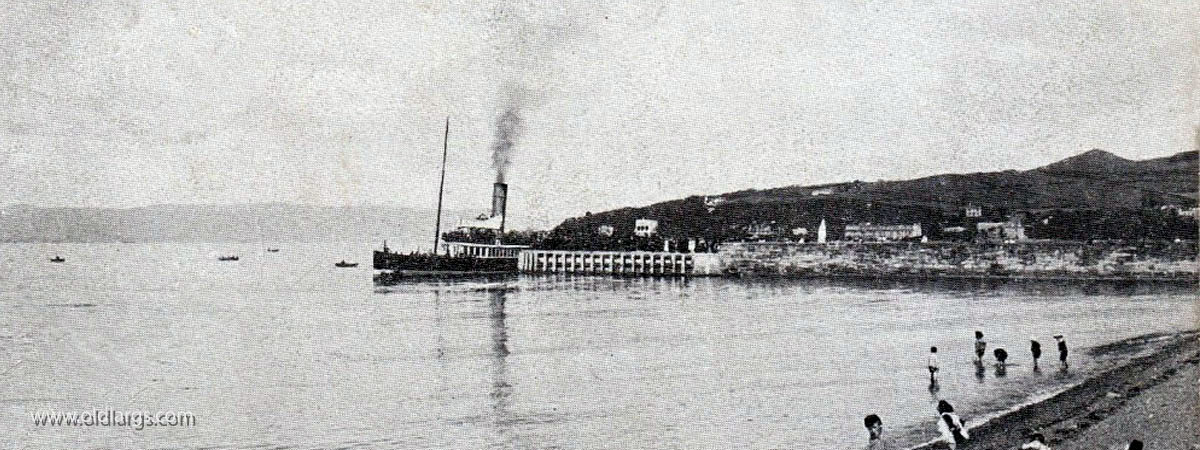
Visitors to Largs Pier. 1900 to the present day.
In this section we will have a look at the ships which were regular visitors to the Largs Pier between the years 1900 and the present day.We are still working on this feature and as you will see have only reached the 1960s. As soon as we can drag some of the Old Largs Web team out of the Achor Bar we hope to add more vessels soon.
If you have any information on a Largs related ships then we would love to hear from you via oldlargs@hotmail.com. Thank You.
The Duchess of Agyll
Built in 1906, By Wm Denny and Bros at Dumbarton.Built for the Ardrossan to Arran run, replacing Duchess of Hamilton. Owned by the Caledonian Steam Packet Company Ltd., Glasgow Requisitioned as a troop transport ship during WW1 and made 655 trips across the Channel, carrying 326,608 men Returned to service in the 1919 season, making the Kyles of Bute and Arran run her own. Moved to the long cruises to Inveraray and Campbeltown in 1936 Remained in service on the Clyde during World War II mainly ferry runs from Fairlie ,Largs and Wemyss Bay. After the war continued on the Clyde. Sold to the used by the Admiralty as a floating laboratory for experimental workat Portland until scrapped at Newhaven in 1970
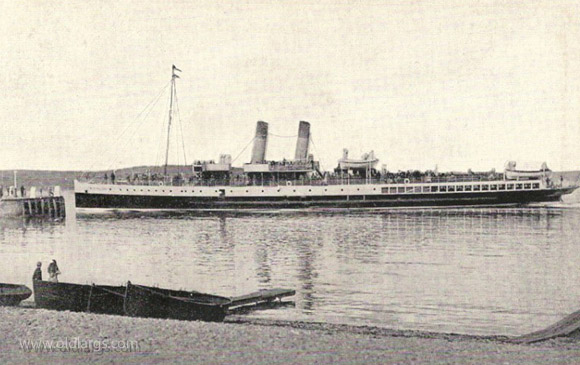
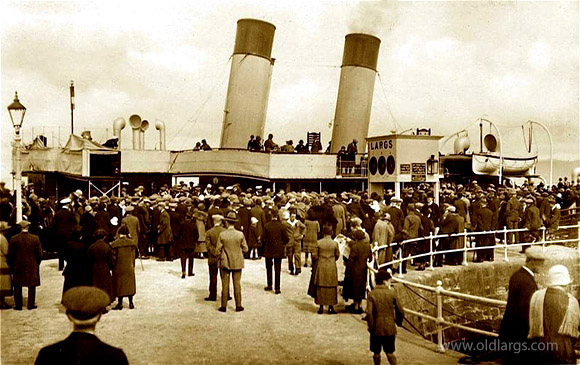
The Duchess of Agyll at Largs
A busy day for The Duchess of Agyll
HMS Monarch at Largs Pier
HMS Monarch was an Orion-class battleship of the Royal Navy. She served in the 2nd Battle Squadron of the Grand Fleet in World War I, and fought at the Battle of Jutland, 31 May 1916, suffering no damage. As a result of the Washington Naval Convention she was decommissioned in 1921 and was used as an experimental and target ship. She was sunk by HMS Revenge in 1925.
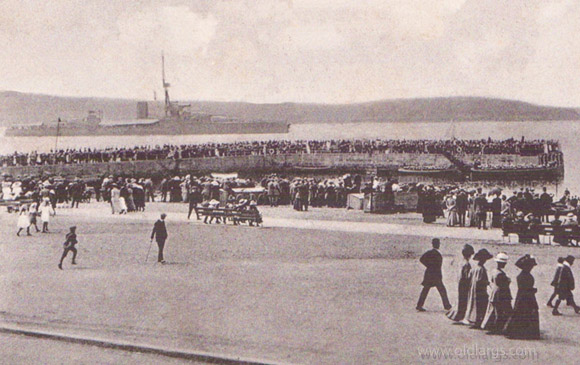
A large crowd welcoming HMS Monarch to Largs
TSS Atalanta
The fourth turbine steamer to run on the Clyde. It was said that her enginies were constructed as models for the larger ones John Brown installed in the giant Cunard Liner Lusitania. Used on the Ardrossan to Arran winter run. Sold on later and ran between Fleetwood and Barrow in Furness. In 1940 she was requisitioned by the Admiralty as a netlayer. Eventially broken up in 1947.

A large crowd welcoming HMS Monarch to Largs
PS Duchess of Fife
Built 1903 by Fairfeild of Glasgow.
A popular lower Clyde steamer used for railway connections and various excursion running on all the Clyde routes. During World War One she was based at Grimsby and Dover as a minesweeper. Again in the second world war she served as a minesweeper. She undertook four crossings between Dunkirk and Ramsgate rescuing a total of 1,633 allied troops.Her final crossing was on 3 June with 300 French troops. She was later awarded a Royal Navy battle honour for her part in the Dunkirk troop evacuation operation.Between the wars she had been on the Wemyss Bay to Millport service. In 1946 she returned to the Clyde she spent time in the Holy Loch run leaving from Gourock. During the summers she back on the Millport run. By 1953 newer diesel vessels were arriving on the Clyde and she was towed to Greenock to be broken up. The ships bell was presented to to the provost of Millport and used as a fog bell at Millport pier.
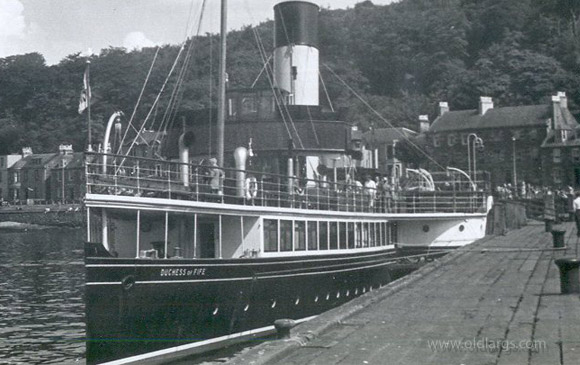
The PS Duchess of Fife at Wemyss Bat pier
PS Jeanie Deans
Built 1931 Fairfeild Glasgow.
A Waverley style traditional paddle steamer. Pre war cruises arpunf Bute. ran all day excursions to Arran, Ayr ,Girvan and Ailsa Craig. Often picking up passanagers from Largs. After the war mainly cruises arround Bute. She was built as LNER's response to the Duchess of Montross and became the flag ship of their fleet. She was their biggest and fastest steamer. In the 50s she became one of the most populare steamers on the Clyde. Withdrawn at the end of the 1964 season she was sold to the Coastal Steam Packet Company who renamed her Queen of the South and operated cruises on the Thames. Sadly mechanical problems dogged her and she was sold to Belgian breakers in 1967.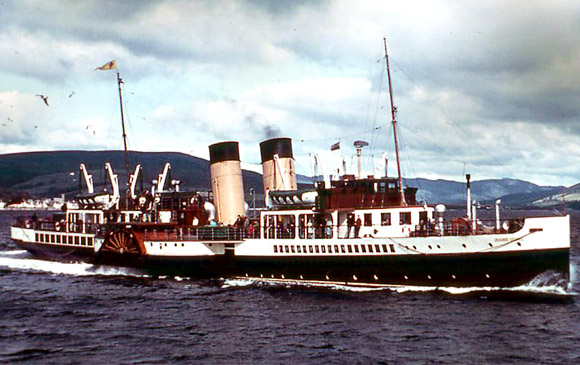
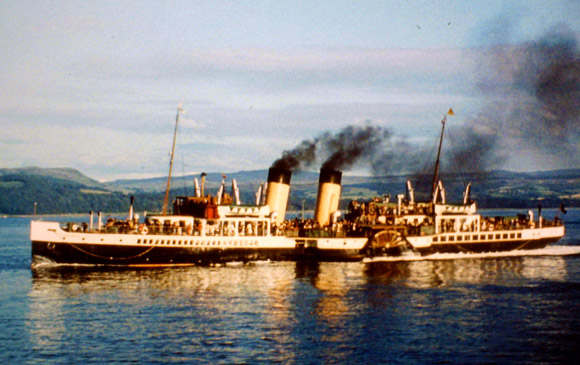
PS Jeanie Deans. Photo provided by Peter Rolf.
Seen WW2 service on the Thames as a mine sweeper.
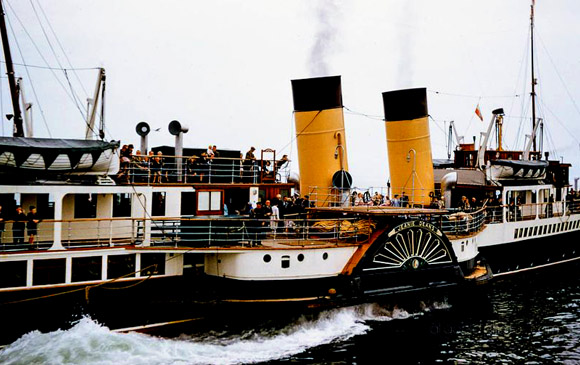
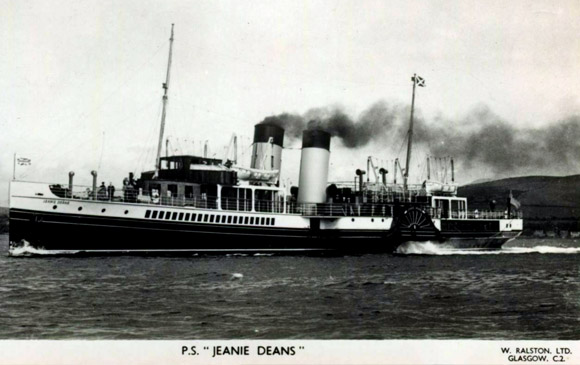
TS Duchess of Hamilton
Built 1932 by Harland & Wolff of Govan.
Built for the Caledonian steam Packet and was used mainly for excursions from Ayr, Troon and Ardrossan. In 1939 she was moved to the Stranraer and Lorne run as a troop ship. After the war she returned to the Clyde and had a major refit in 1956 and was converted to oil burning. By the time she was retired in 1972 she was used for Clyde excursions. Along with the Duchess of Fife and Monstrose she was the greyhound of the Clyde. With captain Fergie Murdoch in the 50s, hhen it was popular for steamers to race each other she would take anything on and win. Mainly took visitors from Gourock around the lower Clyde and to Lochranza and Campbelton. Regular vistor to Largs. She was eventually bought by Reo Stakis to be used as a high class floating restaurant at Glasgow. Unfortunately this plan came to nothing and two years later was towed away to the breakers yard.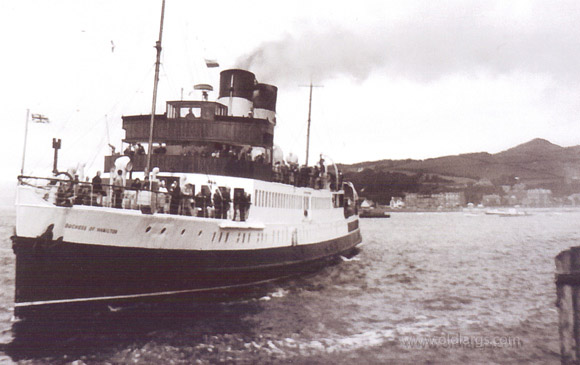
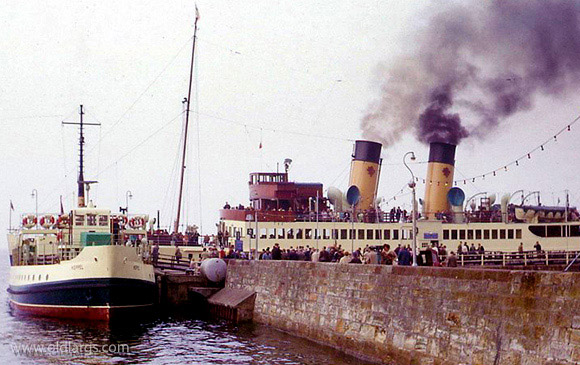
The Duchess if Hamilton arriving at Largs.
The Keppel and the Duchess of Hamilton at Largs. Photo by kind courtesy of Kenny Whyte
DEPV Talisman
Built 1935 by A & G Inglis of Pointhouse
Between 1935 & 1939 the Talisman ran from Craigendoran to the Kyles and was the second ship to bare that name. She was not a steamer. Had unique Direct Acting diesel electric engine powering conventional paddle boxes. This type of engine was extremely fuel efficient and involved 4 diesel engines attached to electric motors. Pre war she ran cruises to Rothesay and Kyles of Bute.She was requisitioned by the admiralty in June 1940 and served as an anti-aircraft ship. She was also involved in the D-Day Normandy landings acting as a HQ ship. During the war she was damaged by gunfire from the French coast and sailed into Antwerp with the first convey after that port was liberated.
On her return to the Clyde in 1946 she was given and refurbishment. In later life she was given new engines and in 1954 took over the Wemyss Bay ,Largs ,Millport and Kilchattan Bay route for 14 years. The Talisman was a challange for most of her Captains to manoeuvre. For what ever reason the Talisman would not always move as the Captain wanted. A stong wind across her bows and she would only go the way she wanted. In addition her bridge controls to the engine room via the telegraphs would often fail.The Talisman's unique engines gave her endless trouble all her working life. However her great fuel economy helped her survive her many years service on the Clyde. She was noisy and rattly but dispite that became a Clyde faverote with passengers. She was enventually withdrawn in 1966 and after 33 years of service she was broken up in 1967.broken up in 1967.
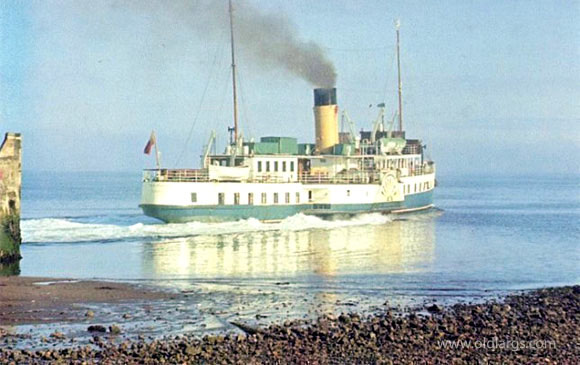
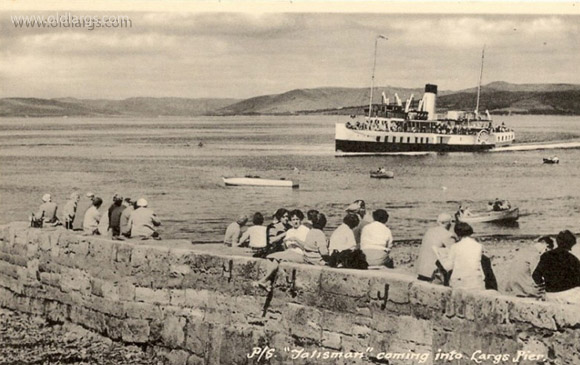
The Talisman leaving Largs on 21.7.66 at 7:45 am on the early morning run from Millport to Wemyss Bay.
The Talisman arriving at Largs
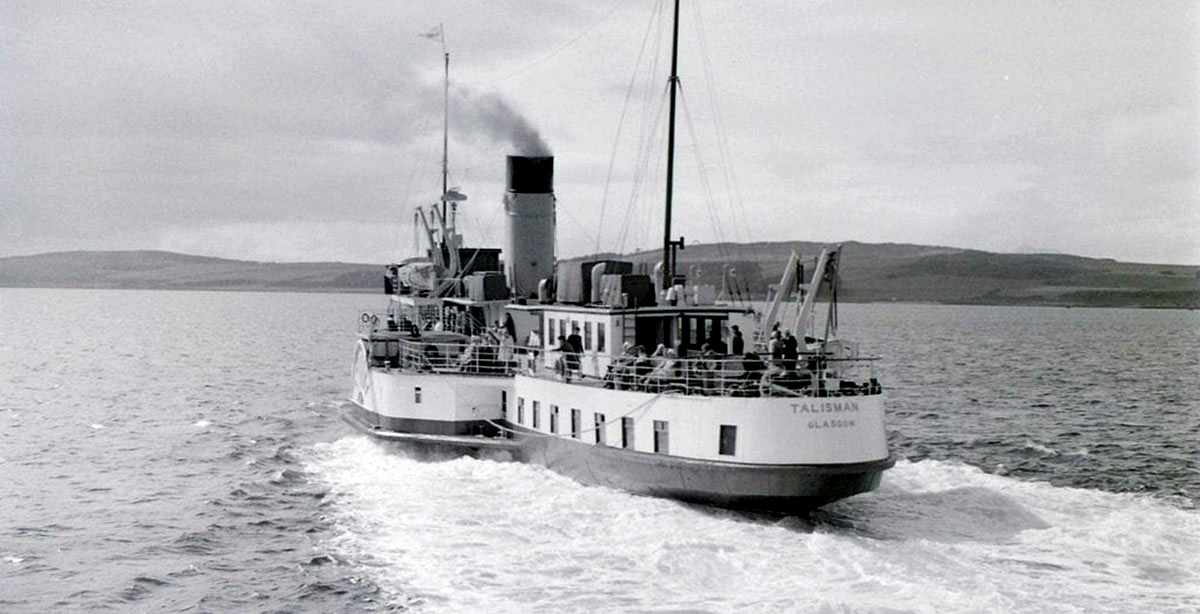
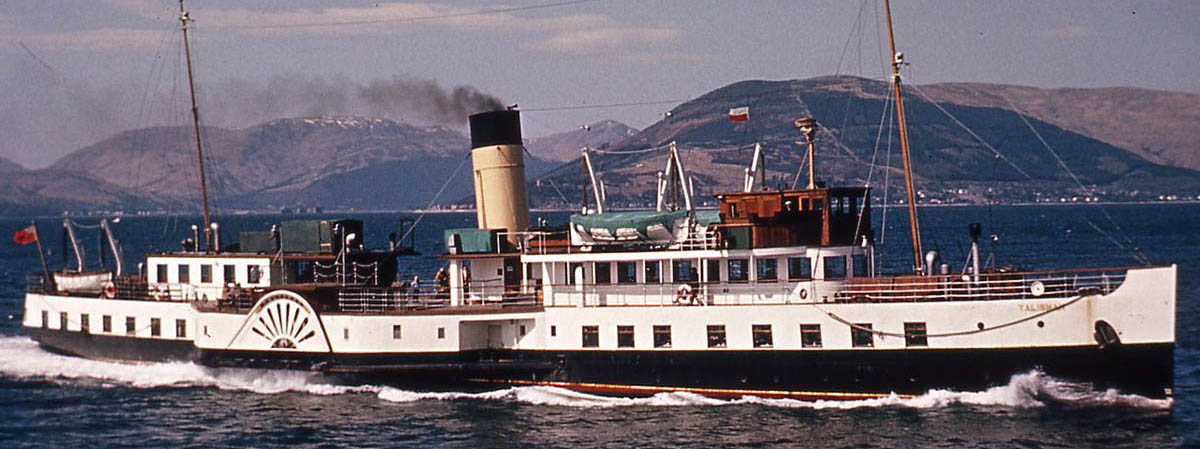
TS Marchioness of Graham
Built 1936 by Fairfield Shipbuilding & Engineering co
She was built for the Arran route was very popular with passengers. From 1939 and the start of the War she maintained the ferry service between Failie, Largs, Millport and Brodick. After the war she returned to her old route from Adrossan to Brodick. When the Glen Sannox arrived she was moved to ferry relief work and Clyde excursions.The rocks on the Cumbrae coast around the Keppel pier appeared to have an unfortunate attraction for her. In April 1944 she went ashore at a spot known as the wishing well. She was eventually re floated. In 1951 she was again approaching the Keppel pier during thick fog when she ran aground again near the pier. passengers were put ashore via one of the ships lifeboats. No serious damage was done.
In 1957 she left the Clyde when she was sold to Greek owners. Her new Greek owners changed completely re built her with new engines and a new superstructure to such an extent she was unrecognisable. She was then used as a private yacht. Then as a cruise ship under the name of Galaxy. Later re named again as El Greco and operated as a cruise ship around the Greek islands. She lasted until 1977 when she was broken up.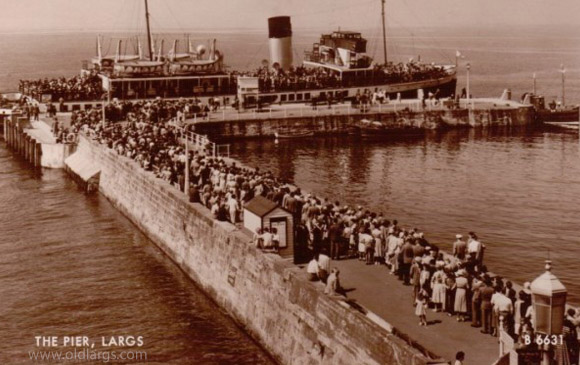
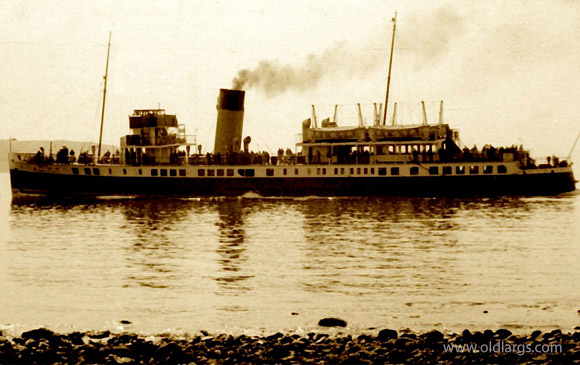
A very popular TS Marchioness of Graham at Largs pier.
TS Marchioness of Graham leaving Largs
TS Queen Mary II
Built 1933 by William Denny & Bros
Built for the Williamson Buchanan sailings from Brdge Whaft Glasgow to the Arran coast. The TS Queen Mary is now regarded as one the finest Clyde excursion steamers ever built with her combination of speed, smoothness, quietness and passenger comfort. She was the world's first passenger turbine ship. When built she was coal fired and had two funnels. Many modifications during her life changed her appearance with the biggest being her modification to one larger funnel in 1957.Built for doon the watter sailings from Glasgow and spent most of her life on this run. Pre war it left Glasgow at 10am on it's run to Arran. In the 195os reduced to the 11am run to Rothesay and Tighnabruaich. She set standards in passenger comfort which kept her in service as the last turbine steamer on the Clyde.
In 1934 when the new Cunard ship (known as 534) was launched the company agreed to add II to her name so that the new Cunard ship, now known as the Queen Mary, could carry the name.
Later in her life she was very popular doing summer excursions round the Kyles to Arran. Her last cruise in 27th Sept 1977 was from Largs to Rothesay. She was withdrawn in 1979 and was purchased by Glagow district Council as a floating museum. However due to local council cut backs in the 1980s this never happened.In 1981 the ship was bought by the Lau family and taken south to London to become the Toby floating restaurant complete with her two oringinal funnels. Later she was moored alongside the Embankment on the north bank of the Thames immediately upstream from Waterloo Bridge with her bows pointing upstream. She was understood to have been the largest vessel to have reached this far upstream.
In 1987 Queen Mary was sold to Bass PLC. She underwent a £2.5m refurbishment in 1997. Facilities included two bars and two function rooms and the top deck of the ship was used as an open-air venue with bar facilities. In 1988 she was restored to 2 funnel profile and moored at Victoria Embankment. In 2011 she was auctioned and sold to a British antique dealer planning to restore her to 1930s glory.In 2012 a charitable group, Friends of the TS Queen Mary, was formed with the goal of returning the ship to a permanent berth in Glasgow. In October 2015 the charity purchased the ship and once made seaworthy was towed from Tilbury to Greenock the following year. The ship's return to the Clyde on 16 May 2016 was her first visit to her former home since 1981. She spent time at the James Watt Dock in Greenock where her restoration started.
On the 9th November 2016 Queen Mary left James Watt Dock under tow for Glasgow on what would be her first visit to the city since 1977. The ship is now berthed at the entrance of Princes' Dock beside the Glasgow Science Centre.Details of the Queen Mary's ongoing restoration can be found on the Friends of TS Queen Mary web site.
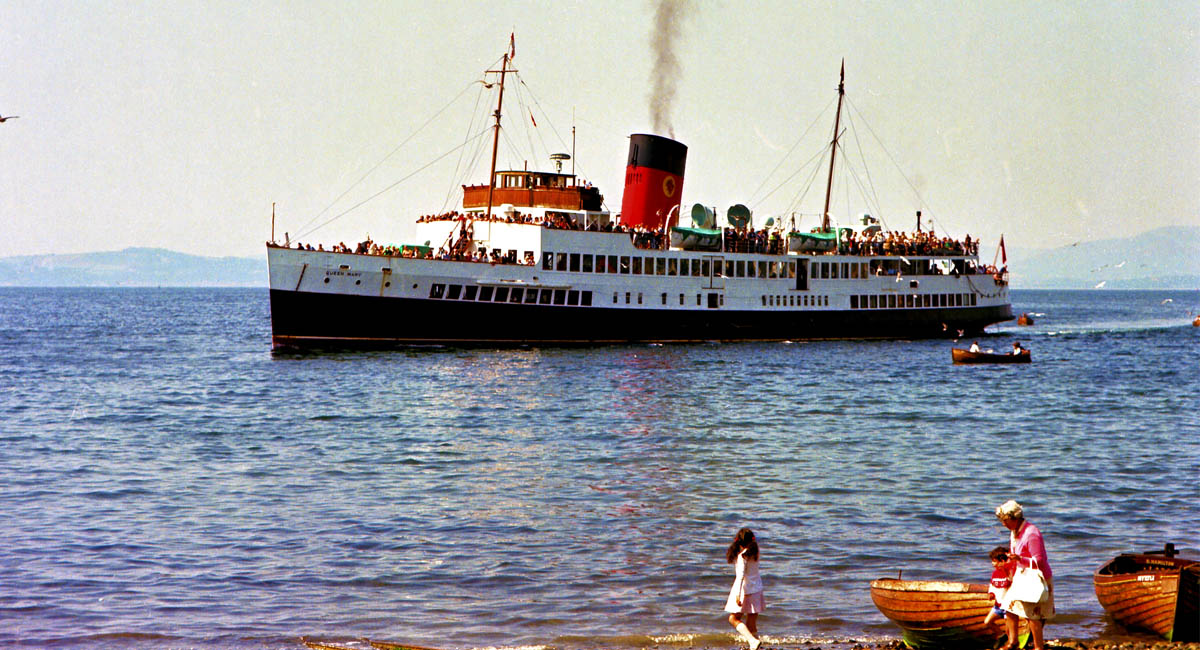
Queen Mary approaching Largs pier. Photo by kind permission of Grahame Ross.
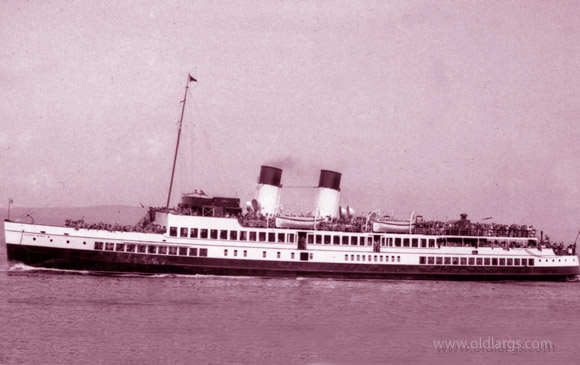
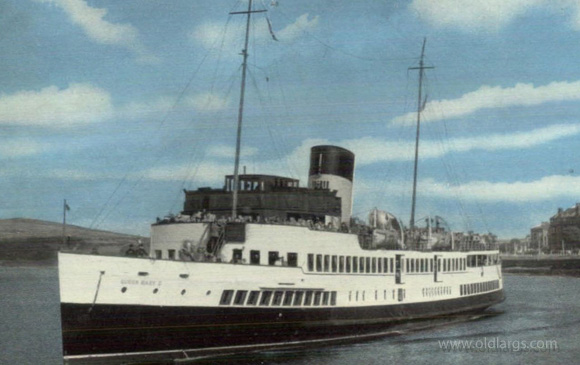
The TS Queen Mary II with her orignial two funnel and one mast layout.
In 1957 she was converted to oil burning which caused the change to one funnel. An additional mast was also added.
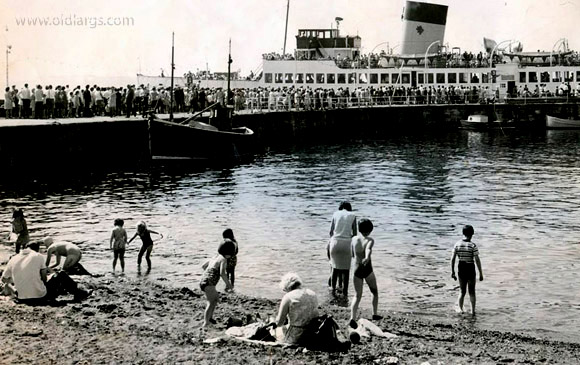
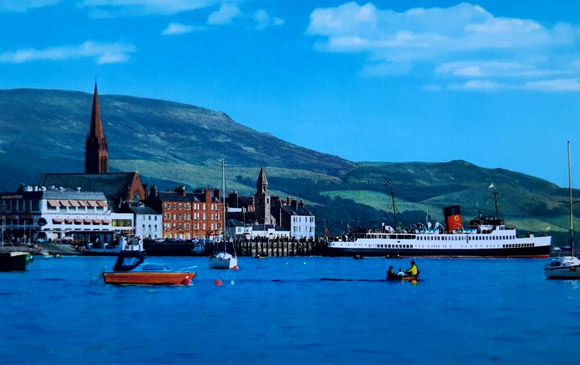
The TS Queen Mary II at Largs
A 1950s mpovie of the TS Queen Mary II on the Clyde.
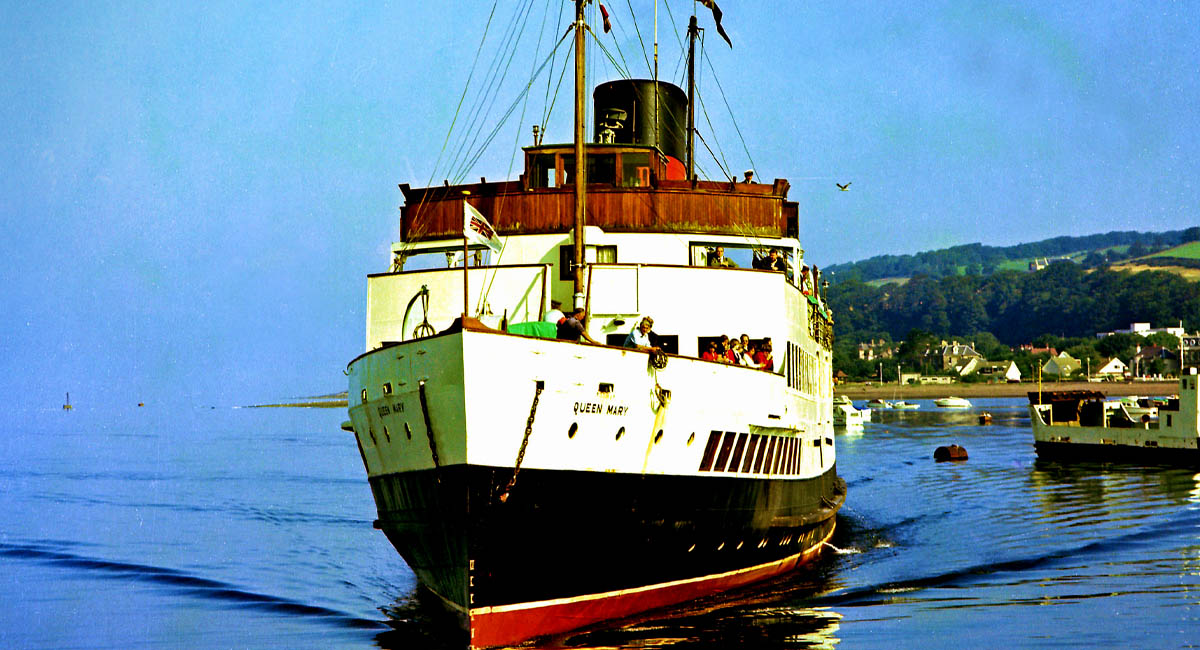
Queen Mary at Largs pier. Photo by kind permission of Grahame Ross.
PS Caledonia
Built 1934 by Wm Denny & Bros of Dumbartion. Lenght 230 feet. 1766 passengers.
The Caledonia had a regular ferry programme connecting Gourock and Wemyss Bay with Dunoon and Rothesay. She also provided cruises to the Kyles of Bute and short cruises from Largs and Millport. She was requisitioned as a minesweeper in 1939 and later in the war was converted to anti-aircraft vessel. A Clyde passenger favourite with great passenger comfort. Did the Arran run in the days before Car ferries. Was popular in the 1950s for Ayr excursions.She returned to the Clyde in 1945 and continued her ferry and excursions role. She was withdrawn from service in 1969 when she was purchased by Bass Charrington and served as a floating pub and restaurant named Old Caledonia on the Victoria Embankment of the River Thames.Unfortunately she was badly damaged by fire on 27th April 1980. She was found not to be worth repair and scrapped. However her engines were saved and preserved at the Hollycombe Steam Fair Park at Iron Hill, Liphook, Hampshire They are currently looking for volunteers to renovate the engine for display.
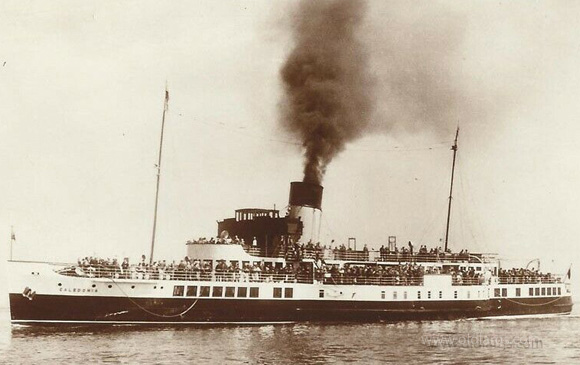
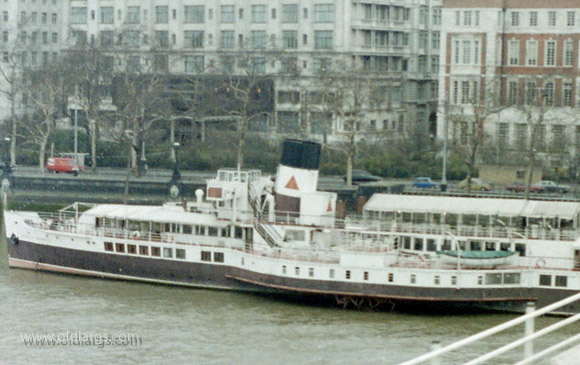
The PS Caledonia.
PS Caledonia at the Victoria Embankment of the River Thames.
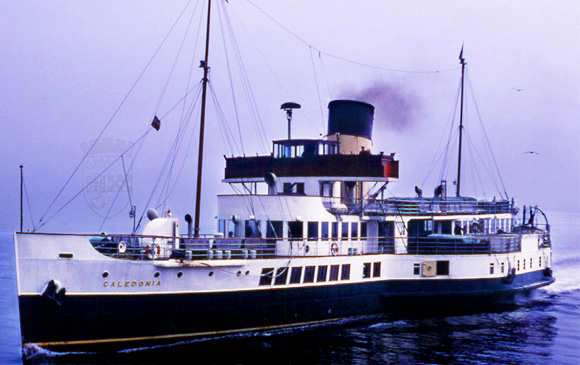
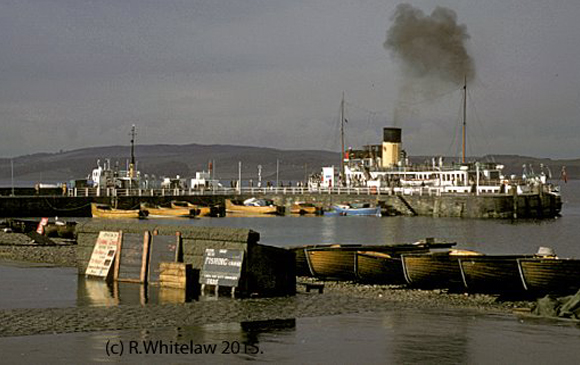
The PS Caledonia.
PS Caledonia and the Keppel at Largs 1968. Photo courtesy of Robert Whitelaw.
TSMV Wee Cumbrae
Built 1935 by Wm Denny & Bros Dumbarton
The small motor vessel Wee Cumbrae had two Gleniffer diesel engines. She could take 60 passengers. To begin with she had no accommodation for passengers on desk, but by 1936 decking rails had been added. She ran the Largs to Millport ferry run until 1948 when she was moved to the Gourock Dunoon run. In 1953 she was retired from the Clyde, given new engines and sold to a company in Brunei as a tug for timber rafts.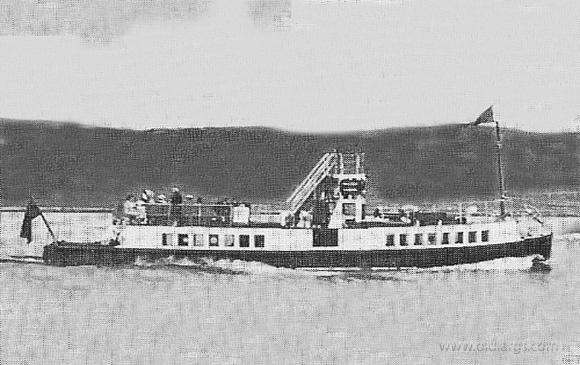
TSMV Countess of Breadalbane
Built 1936 by William Denny & Bros
For such a small vessel the Countess of Breadalbane had a long and eventful career. An entire book could be written about its career as few ships have managed to sail on both the open sea and enclosed inland fresh water in its life time. We have put together just a small account of her adventures.The Countess was a regular visitor to Largs between 1954 and 1963 providing a link to Millport and Rothesay along with charter sailings and afternoon and evening cruises.
She started off life being built, then dismantled and transported in sections to Loch Awe. By May 1936 she was re build and started her popular daily sailings in the Loch. With the outbreak of war in 1939 she was moth balled and laid up at Loch Awe station. After the war the Loch sailing runs were never as popular and in 1951 she was withdrawn. You would think this would have been the end however in 1952 she was dismantled and over a challenging four week period was moved over land to Loch Fyne to Inveraray.By 1954 she was on the Clyde visiting Largs often. During the winter months she was Craigendoran ,Gourock and Holy Loch run. However as a winter vessel she was very unpopular as she was considered small and not sufficiently sea worthy. During one winter it rumoured that the Talisman was going to be sold out of the Clyde. The next morning large bill posters with the words "Sell the Breadalbane not the Talisman" were found plastered all over Clyde Steamer timetable boards and all over many pier building. Two morning later posters were found displayed at Kirn and Hunters Quay worded as follows "Cheap for immediate disposal, for quick sale the desirable vessel Countess of Breadabane complete with oars, guaranteed safe in calm water"
By 1965 she became the fulltime Largs to Millport vessel with all of her other excursion duties s taken over by the newer Maid of Skelmorlie and Maid of Cumbrae vessels. In 1971 she was sold to Walter Roy Ritchie of Gourock and renamed Countess of Kempock and was deployed on many of the same Clyde passenger ferry runs she had done in the 1960s. She was sold again and ended up as a ferry in the Sound of Iona.
Amazingly by 1982 she was heading back in land to freash water. She was purchased Alloa Breweries and in April of that year was removed from the Clyde, cut into two sections and transported to Balloch by road where she was rebuilt. She entered service on Loch Lommond with the new name of Countess Fiona along with a new funnel. Based at Balloch she ran cruises to Luss, Rowardennan and Inversnaid. OIn 2nd May 1990 it was announced her schedule had been “temporarily suspended” until further notice. in fact the new company that owned she had actually gone bust. Sadly the Countess of Fiona was pulled onto the Loch Lommond slipway and left to rot. In 1992 Dumbarton District Council were persuaded to purchase the Countess however in September 1999 with much public anger she was broken up where she lay.
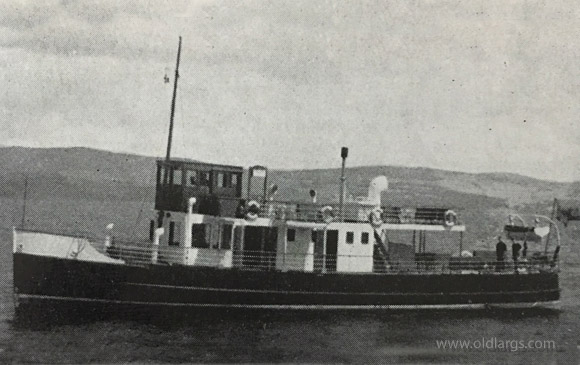
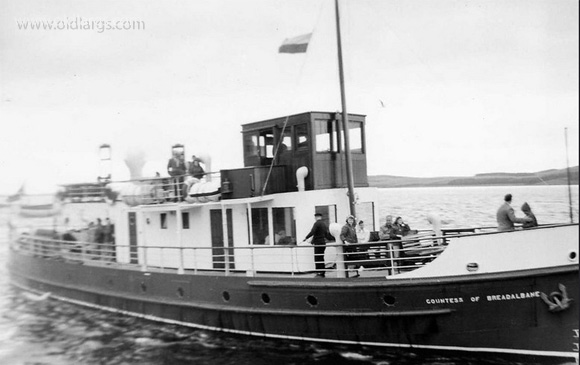
Countess of Breadalbane. Her small funnel at the rear was actually her galley chimney.
Countess of Breadalbane at Largs in 1967. Image by kind permission of Alan Waddell.
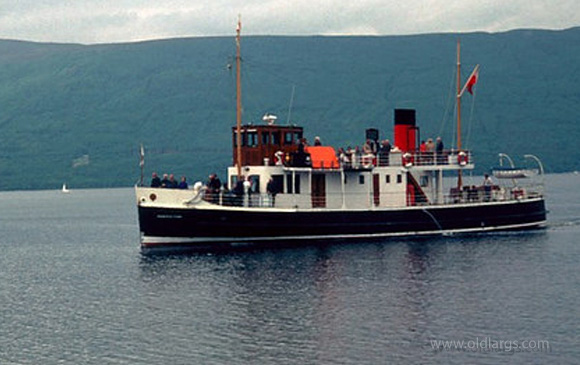
The re named Countess of Fiona on Loch Lommond.
An old Movie Reel clip of the Countess being moved overland from Loch Fyne to Inveraray in 1952.
PS Juno and the PS Jupiter
Built 1937 by Fairfeild Shipuilding & Engineering Co Ltd
The Juno and Jupiter were sister ships built for Clyde and Ayrshire sailings. During her War service the Juno was lost and sank when it was bombed in the London Blitz on the Thames in 1947. The Jupiter supported the Normandy landings. On her return to he Clyde after the war she was very popular offering a the Cumbrae Circle Cruise around Cumbrae calling at Largs, Rothesay and Wemyss Bay.She was a workhouse of the Clyde in the days before car ferries. In the 50s was replaced by new ferries and relegated to afternoon cruises on the Rothesay run.

PS Juno
PS Jupiter
MV The Second Snark
Built in 1938 by Denny, William & Bros Ltd, Dumbarton
MV The Second Snark was built in 1938 by William Denny for use in their Dumbarton shipyard as a tug and tender, replacing their previous steam driven vessel The Snark. From 1960 to 1963 she provided summer cruises on the Firth of Forth, returning to the Clyde in winter. From 1969, The Second Snark was based at Greenock's Victoria Harbour.She provided cruises on the Firth of Clyde and was a popular and frequent visitor to Largs and Millport. In 2018 she was to a billionaire businessman who intended to utilise her as a tender to his racing yachts in France. However, by 2019 she was acquired by a preservation group with substantial and returned to Fairlie. In 2020 the vessel was moved to the James Watt Dock in Greenock and where restoration work in currently in progress.
More details of her restoration can be found here https://www.facebook.com/secondsnark/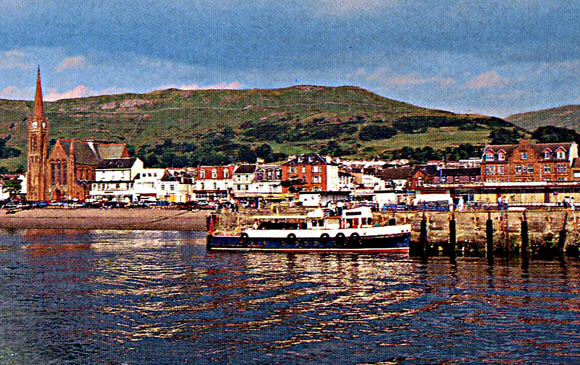
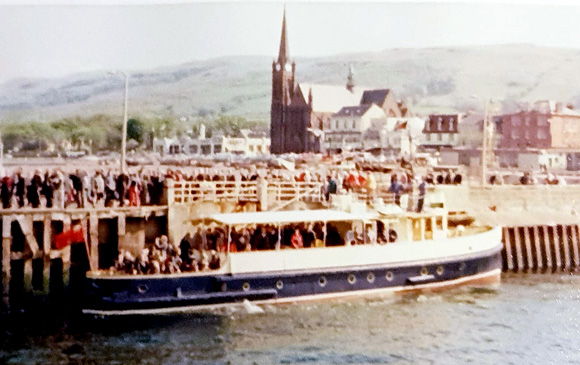
The Snark at Largs
Looks like a lovley day for a cruise on the Snark
PS Waverley

Built 1946 by A&J Inglis, Pointhouse, Glasgow
The Waverley was launched on the 2nd October 1946 at the A&J Inglis Yard which was located where the Glasgow Riverside Museum of Transport is today. She was the last of the great paddle steamers to be built and although built post war her design reflects the pre war style of paddle steamers.In 1947 she made her maiden voyage for the London & North Eastern Railway (LNER). Based at Craigendoran she spent her first years on the Loch Long Arrochar run along with the PS Jeanie Deans. In 1953 she was taken over by the Caledonian Steam Packet Company (CSP). During this period her funnels were repainted yellow with a black top. Over the next 20 years she was seen all other the Clyde.
In 1962 the Waverley's original funnels were renewed. The replacement funnels were slightly out of parallel giving an odd appearance. This was eventually fixed in her 2003 refit. 1965 seen the Waverley's hull painted "monastral blue" until 1970 when the hull colour changed back to black when her owners at the time, Caledonian Steam Packet Company ,was taken over by the Scottish Transport. In 1973 they in turn merged into Caledonian MacBrayne Ltd (CalMac).By the early 1970s the Waverley was now unique. Her Clyde competitors and sister ships including the Talisman, Caledonia, Jeanie Deans and the various Duchess’s had all gone from the Clyde. CalMac withdrew Waverley after the 1973 season. She was costly to run and required a major refurbishment. By this time the Paddle Steamer Preservation Society had been set up. They had been taking a keen interest in the Waverley for years. CalMac were keen to ensure that the ship was preserved and famously sold her to the PSPS for £1. They resumed sailing the following year and changed her colours approximating her original LNER glory.
In 1977 she left the Clyde for the first time to run cruises from Liverpool and Llandudno. This short break from the Clyde continues today with the Waverley visiting Bristol, the Thames and the South Coast as part of her sailing season.In 1997 the Heritage Lottery Fund announced plans for a massive reconstruction of the Waverley and between 2000 and 2003 the ship underwent a complete rebuild and re boilering at George Prior at Great Yarmouth. The total cost was £17 million. Since then the Waverley has been a regular feature on the Clyde during the summer months along with regular cruises from Oban to the Western Isles during the spring. Since being sold to the Paddle Steamer Preservation Society for £1 she has carried more than five million passengers.
Her summer season from early June to September will see her visit the Largs pier regularly. Over the last few years she has often berthed overnight at Largs instead of returning to Glasgow after a cruise. Glasgow passengers are transported down to Largs by bus to meet her. We are most fortunate that from Largs we can easily jump on the Waverley and cruise to places such as the Holy Isle, Lochranza, Campbeltown, Tarbet on Loch Fyne, Loch Long, The Kyles of Bute and be returned to Largs.An Old Largs team favourite is the cruise from Largs to Tarbet on Loch Fyne via the magnificent Kyles of Bute. Time for a quick pint in the Tarbet Hotel and then back to Largs.
In May 2019 it was announced that the Waverley had been withdrawn from service and required new boilers to continue sailing again. Work on the 73-year-old ship's boilers had been on-going since February. It was hoped repairs could be carried out in time for the launch of its 2019 summer sailings from the River Clyde in Glasgow. However the on-going repairs were not successful. The Waverley was taken out of service and the owners announced that the Waverley required new boilers for the ship to continue sailing in the future.Waverley Excursions, the charity which owns the Waverley launched an appeal to raise the £2 million pound required for the repairs. The response from the public was amazing and the funding appeal hit its target of £2.3m by December 2019. This was boosted by a £1m contribution from the Scottish Government.
On Tuesday 14th January, The Waverley was towed from Glasgow to Greenock for her boiler refit to begin. She was berthed in the James Watt Dock at Dales Marine Services shipyard. Her twin iconic funnels were removed to allow access to the Boiler Room. Both boilers were removed in addition to old electrical generators which were also replaced as part of the project
Waverley’s two new boilers were fitted in the first few days of April 2020. Three new alternators were also installed, new electrics were fitted and the passenger toilets and dining saloon were refurbished. Each boiler weighs 21 tonnes apiece. They were built by Cochran Boilers Ltd who are based in Annan. Waverley undertook sea trials on Thursday 13th & Friday 14th August on the upper Firth of Clyde. These were a success and a short three week schedule of Clyde sailings were announced.The Old Largs Web team have already booked their sailing on Wednesday 26th August for the Largs to Tarbet cruise. We will post photos shortly.
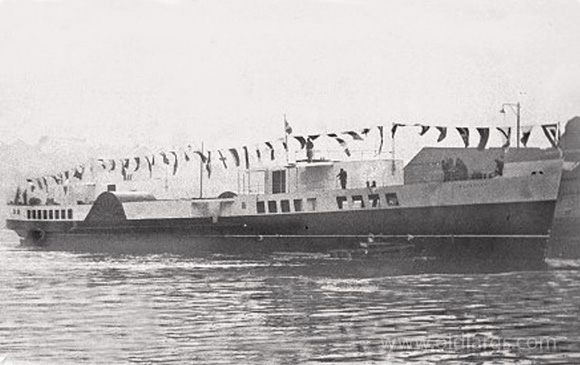
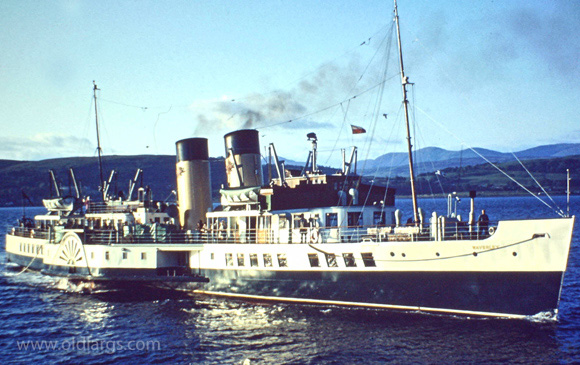
PS Waverley just after its launch in 1946.
The Waverley in her 1953 Caledonian Steam Packet Company (CSP) colours.
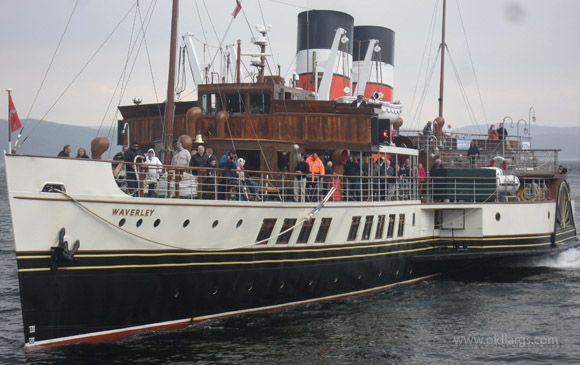
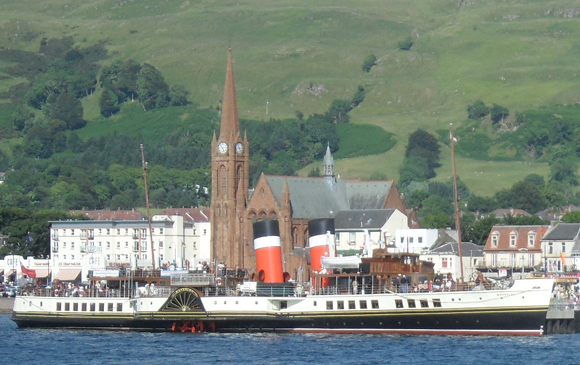
The Waverley can travel at 14 knots in service. Trials speeds in 1947 seen her make 18.37 knots.
The Wavwerley at Largs Pier.
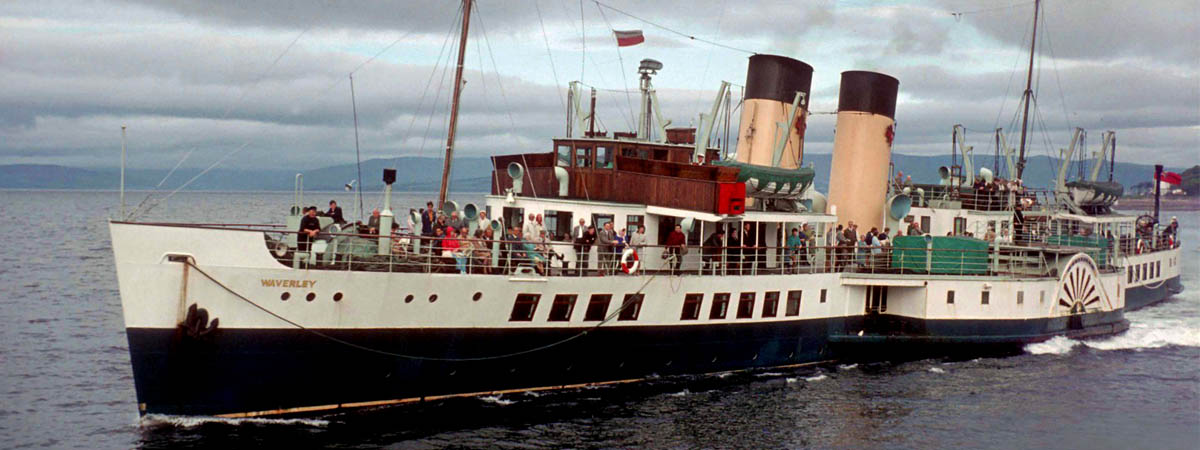
The Waverley approaching Largs in 1969
The Four Maids
In 1954 The British Transport Commission announced 4 new diesel vessels were to be built for the Clyde services. They were to be passenger ships only to provide shuttle services between the mainland and the Cowal Coast, Bute and Cumbrae. The new ships would be named Maid of Ashton, Maid of Argyll, Maid of Skelmorlie and Maid of Cumbrae. The Maids popularity grew and they soon established themselves as ferries and cruise ships and went on to serve the Clyde for nearly 20 years.The Maid of Argyll was built in 1953. Her main run was between Craigendoran and Rothesay and sailed the Lochgoilhead and Arrochar runs at the weekends. Winter would often she her visiting Largs as part of the Cumbrae service. She left the Clyde in 1974 when she was sold to new Greece owners.
The Maid of Ashton ran her sea trails on May 21st 1953 and took up the service between Gourock, Kilcreggan and the Holy Loch on May 25th. She was withdrawn at the end of 1971 and sold to new owners as a floating Club on the Thames. She is still on the Thames now renamed R.S. Hispaniola and is currently a restaurant ship permanently moored on the Victoria Embankment opposite the London Eye. Looking at her web site https://hispaniola.co.uk/ she is almost unrecognisable as the small Clyde Ferry.The Maid of Cumbrae was the most frequent visitor to Largs of all the Maids. She sailed on day excursion trips from Glasgow to Dunoon. And afternoon cruises to the coast towns. In winter seen her on the Millport and Rothesay runs. The Maid of Cumbrae was the last Maid to be built. The maids were sparse and bare compared to the luxury of the earlier paddle steamers but gave great service. In 1972 she was modified to carry cars and was sent to the Gourock to Dunoon run. She could carry 15 cars and this gave her a new lease of life. In 1978 she was sold to Italian owners and re named the Hanseatic. Later in 1984 she was renamed Capri Express. She spent her last days operating out of Trieste and then Naples. She was eventually broken up in 2006.
The Maid of Skelmorlie went into service at the end of June 1953 and operated afternoon and evening cruises from various coast towns being used for other services as required. She also inaugurated Cafe cruises in which the fare included a cup of coffee and a chocolate biscuit. She was often employed in services to Millport and Rothsay in the winter. In April 1973, she was sold to an Italian concern and sailed for the Mediterranean. She was converted to a stern-loading car ferry, and renamed the Ala. She had considerable success operating in the Bay of Naples operating for almost twenty years from early 1976. After the 1995 season the Ala was laid up and took various charters: from 1997 to 1999 a winter cargo service to the Tremiti Islands in the Adriatic. In the summer of 2001 between Pozzuoli and the island of Procida she sailed in the company of her old Clyde friend ,The Capri Express, (ex MV Maid of Cumbrae). As late as 2004 she was still working as a ferry between Naples and Sorrento. From 2014 she has been laid up at the San Vincenzo wharf in central Naples.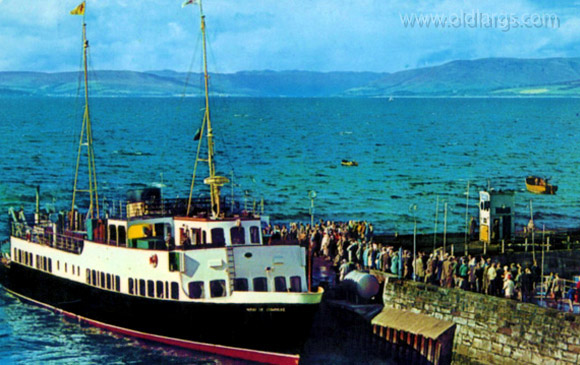
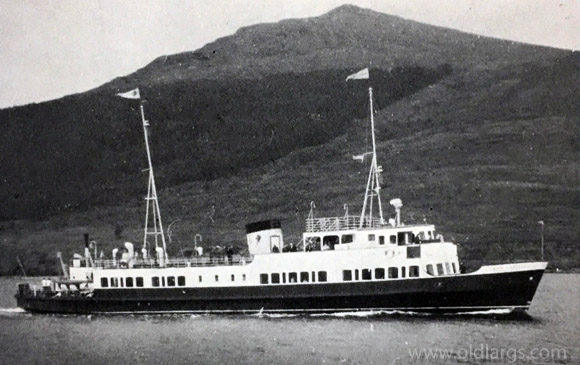
The Maid of Cumbrae at Largs Pier.
The Maid of Argyll
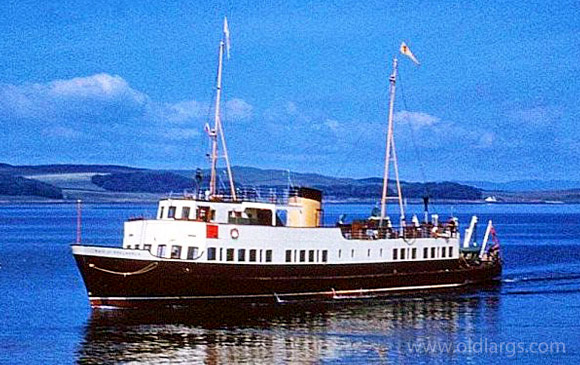
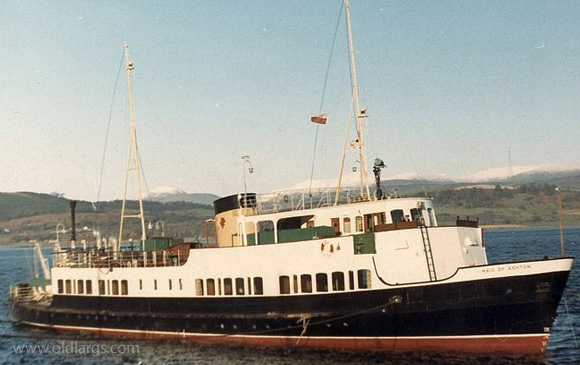
Maid of Skelmorlie
Maid of Ashton
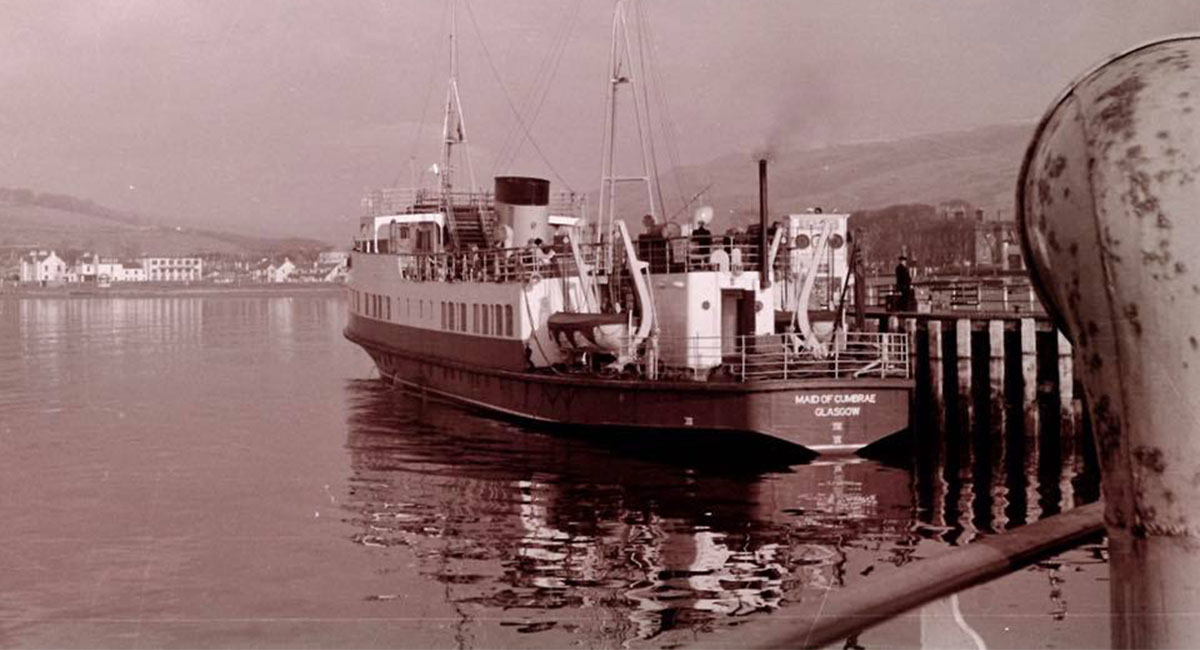
MV Keppel
Built 1961 by J S White & Co of Cowes.
we are quickly moving into the 1960s to look at TheKeppel. The fondly remembered Keppel started off life on the Thames under the name of Rose for owners British Railways Eastern Region. In 1967 Rose became surplus to the needs of B.R. and was transferred to the Caledonian Steam Packet Company on the Clyde where she was renamed Keppel. After modifications she was placed onto the Largs to Millport route, a service she carried out for almost 20 years.Keppel served the Largs to Millport service for many years and in her later years offered Clyde cruises and Clyde resort sailings. Even although a basic car and passenger ferry service was introduced between Largs and Cumbrae in 1972 Keppel still maintained the passenger link with Millport with considerable success. In the mid 1980s she performed Cumbrae Circle cruises in between her service sailings from Largs and Millport.
During the Glasgow Garden Festival in 1988, Keppel provided cruises from the heart of Glasgow to the Clyde coast. The decline of Clyde passenger numbers caught up with The Keppel in the early 1990s and she was eventually withdrawn from the Clyde at the end of the 1992 season. She was sold to new owners in Malta and the little ship left the Clyde on 22nd April 1995.Keppel started her Malta cruising in 1997. She is still in a very good condition and is used as a cruise boat in the mornings and a party boat in the evenings. Her Maltese owners have extended her career on cruises out of Valletta, and later for cruises to and from the island of Comino. She is still called The Keppel.
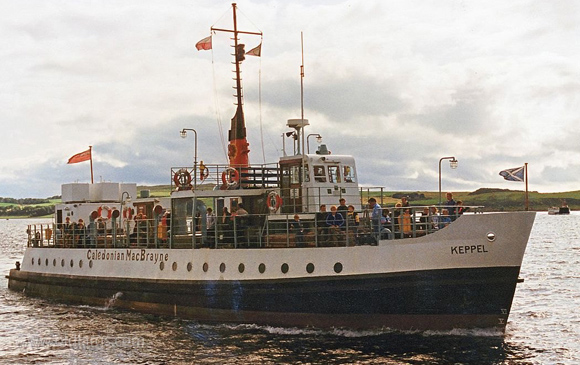
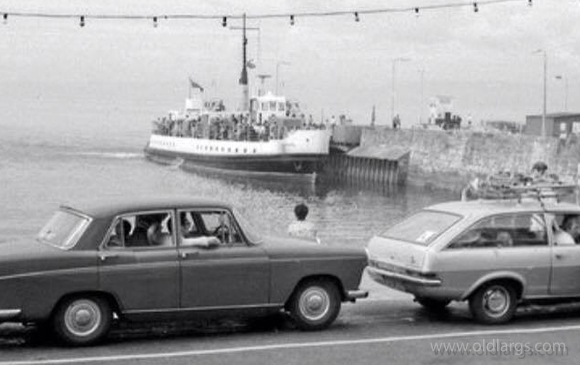
The Keppel just off Largs.
The Keppel at Largs Pier.
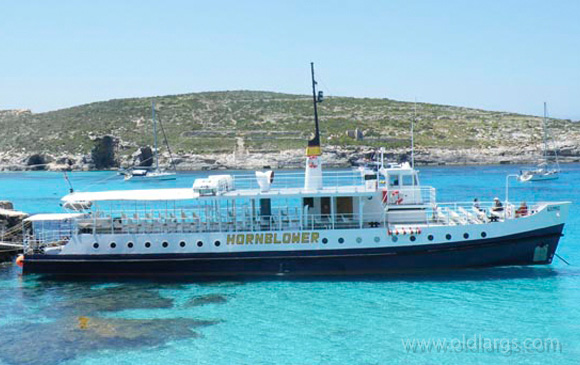
The Keppel today, enjoying slightly warmer waters than she did in her Clyde days.
A old You Tube video showing the Keppel on the Clyde.
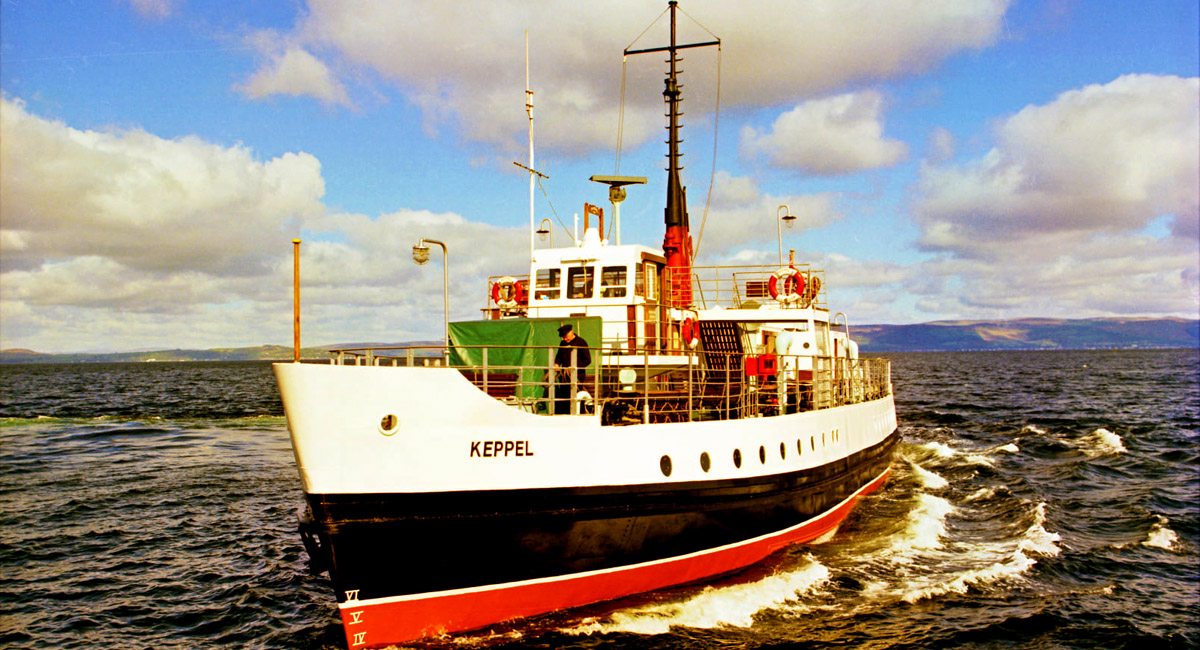
RMS Columba / MV Hebridean Princess
Built in 1964 by Hall, Russell & Company Aberdeen
RMS Columba was the last of three car ferries built in 1964 for the Secretary of State for Scotland after he ordered three identical car ferries for the Western Isles. They were all chartered to David MacBrayne Ltd and were all equipped to serve as floating nuclear shelters with water tight doors to be used by the government in times of emergency. Columba was the last of the three to enter service and took up the Isle of Mull service, replacing the elderly ships MV Lochearn and MV Lochmor. She continued on this route for nine years.Columba's interiors, and those of her sisters MV Hebrides and MV Clansman, were designed by a young Scottish designer, John McNeece, who was to go on to design the interiors of numerous cruise ships over the next 40 years. Cars were loaded via a forward hydraulic hoist. She sailed between Mull, Stornoway, Mallaig, Lochboisdale, Castlebay, Armadale on her Skye service Later moved to Oban, serving Coll and Tiree, Colonsay, Iona, Lochaline and Tobermory. She also ran special cruises to places like St Kilda. By 1985 she was the last dedicated hoist-loading vessel in service.
In 1988 she was purchased by Hebridean Island Cruises to serve as a luxury cruise ship. She underwent a major refit and was renamed MV Hebridean Princess. Few traces of those ferry days remain though the next time she is at Largs Pier have a close look at the hull you can still make out the large Caledonian Macbrayne writing engraved deep below coats of newer paint. She began operating on 26 May 1989 and provides luxury cruises around the Western Isles of Scotland. Recently she has been offering cruises to Ireland, Orkney and Shetland Islands, the Norwegian Fjords, Amsterdam and Antwerp. Another refit seen the removal of the car-carrying facility when additional cabins were added to increase her capacity to 49 passengers. Queen Elizabeth II has chartered the ship twice. Once in 2006 for her 80th birthday and again in 2010 to Celebrate Princess Anne’s 60th and Prince Andrew’s 50th birthdays. The Queen reportedly paid £125,000 for the use of the ship on each occasion.Hebridean Princess is totally all-inclusive. Your fare includes everything from meals including dining and picnics ashore. Entrance fees at places of interest, Wi-Fi, transfers and parking. All drinks including champagne and single malt whiskeys are included. She is often seen at Largs Pier and moored of the Cumbrae slip in late October as part of her 7 night Splendour of Argyll and Bute cruise. Prices for that cruise start at £5420. That’s £5420 per person in case you were wondering.
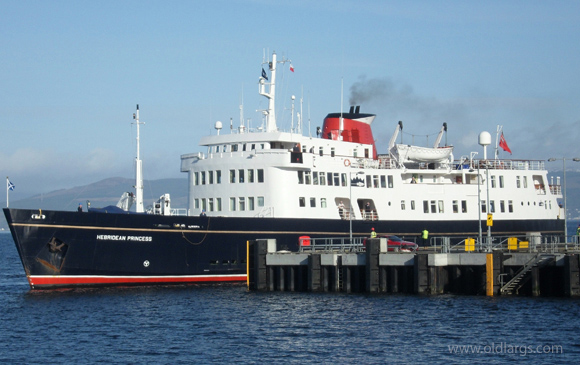
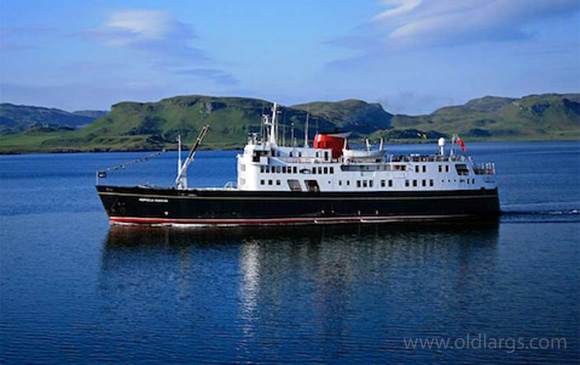
Hebridean Princess at Largs Pier
The Hebridean Princess.
